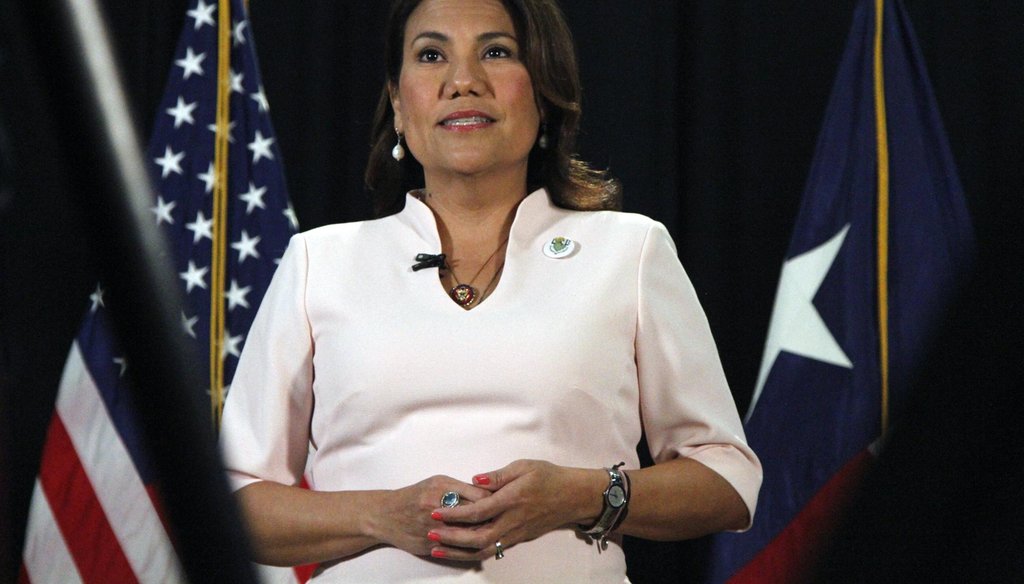

Our only agenda is to publish the truth so you can be an informed participant in democracy.
We need your help.


U.S. Rep. Veronica Escobar, D-El Paso, delivers the Spanish-language response to President Donald Trump's State of the Union Address on Feb. 4, 2020 (Cedar Attanasio/Associated Press).
Rep. Veronica Escobar, D-Texas, took aim at the tax law that President Donald Trump signed into law in 2017, saying it has ballooned the debt.
"The president has exploded the debt by more than $3 trillion — all to give billion-dollar tax cuts to the wealthiest few," said Escobar, the lawmaker tapped to respond to President Donald Trump’s State of the Union address in Spanish. (The Spanish version of the statement was, "El presidente ha disparado la deuda por más de 3 billones de dólares, todo por recortarle miles de millones de dólares de impuestos a los más ricos.")
Escobar is in the ballpark on the amount, but she’s exclusively blaming Trump when in fact her own party contributed to the passage of other laws that also increased the debt significantly. She also overstates that the impact of the tax cuts by singling out only "the wealthiest few." (Escobar’s office did not respond to an inquiry.)
There are two ways of measuring the federal debt, and both get you to around $3 trillion. The debt held by the public rose by about $2.8 trillion between Trump’s inauguration in 2017 and the day before his State of the Union address. A broader measurement, gross federal debt, includes public debt plus the debt owed by one part of the government to another. That rose by a bit over $3.3 trillion over the same time period.
While Trump’s tax bill, which passed only with Republican votes, was one of the main reasons for the increase in debt, it wasn’t the only one.
The Committee for a Responsible Federal Budget, a fiscally conservative group, last year estimated that two other bills — the major federal spending bills that passed in February 2018 and August 2019 — jointly increased the debt by about as much as the tax bill did through 2019. Other bills added a smaller amount.
The spending bill approved in 2018 passed with the support of most Senate Democrats and a bit over one-third of the House Democratic caucus. The spending bill approved in 2019 passed with the support of most Senate Democrats and the overwhelming majority of House Democrats.
Escobar’s statement does not acknowledge this broad Democratic support for bills that played a significant role in increasing the debt.
The tax cut does provide tax breaks for the wealthiest few, and lots of other people, too.
The cuts are projected to total $1.8 trillion over the next decade, according to the Tax Foundation, a think tank with a pro-business leaning.
In 2018, about 80% of taxpayers had a tax cut due to the new law, according to the Urban Institute-Brookings Institution Tax Policy Center, an independent group that models the effects of tax legislation.
The savings skew toward high-income earners. The center said 21% of the total tax savings went to the highest-earning 1% of taxpayers in 2018, more than the total for the bottom 60%.
By 2025, that gap is projected to increase, with 25% of the tax savings going to the top 1%.
The increases are larger for higher-income earners on a percentage basis as well — not just in raw dollars. In 2025, the top 1% are expected to see after-tax income grow by 2.9%, compared to 1.4% or less for the bottom 80% of income earners.
Escobar said, "The president has exploded the debt by more than $3 trillion — all to give billion-dollar tax cuts to the wealthiest few."
She is in the ballpark on the scale of the increase. However, while an independent analysis found that that tax law has added to the debt, it also found that a similar amount was added to the debt by two spending bills that Democrats largely supported prior to Trump’s signature. And while the tax cut does provide tax breaks for the wealthiest Americans, it cuts taxes for lots of other people, too.
We rate the statement Half True.
Veronica Escobar, response to the State of the Union address in Spanish, Feb. 4, 2020
Treasury Department, debt to the penny calculator, accessed Feb. 4, 2020
2018 omnibus spending bill, with Senate and House votes on final passage
2019 omnibus spending bill, with Senate and House votes on final passage
In a world of wild talk and fake news, help us stand up for the facts.
